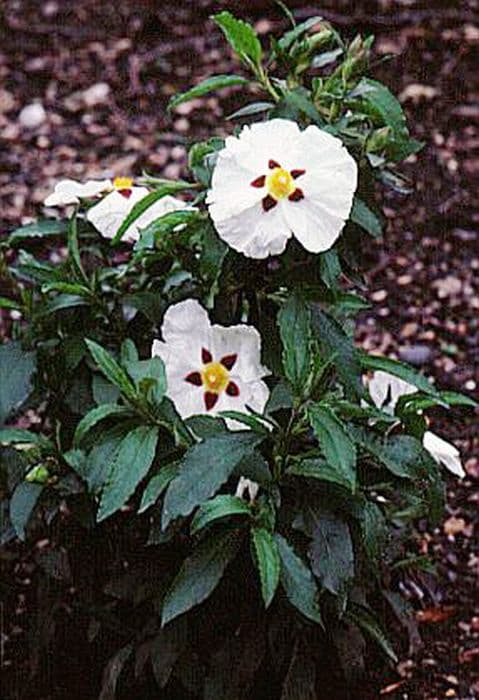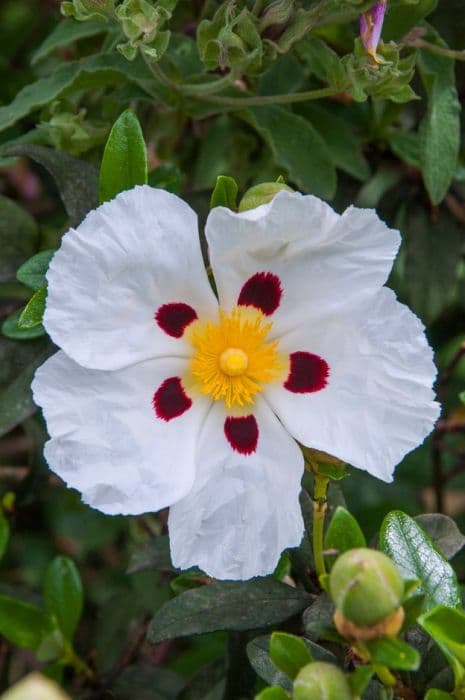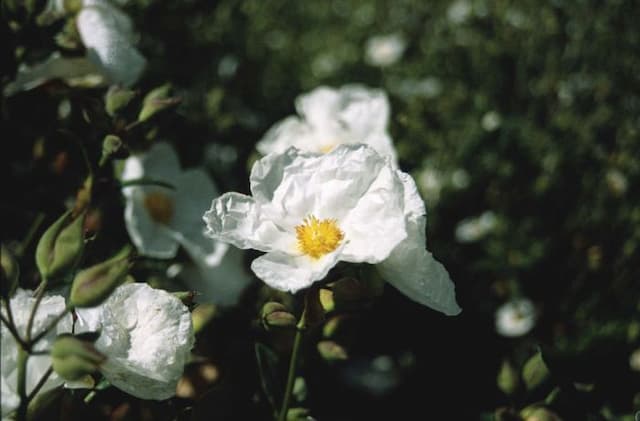Laurel Rockrose Cistus laurifolius

ABOUT
Cistus laurifolius, commonly known as laurel-leaved rockrose, is a distinctive plant with a bushy, rounded appearance. It is characterized by its evergreen foliage, with leaves that resemble those of a laurel, hence the name. The leaves are dark green, glossy, and have a leathery texture, presenting a robust and rich appearance. Each leaf has a wavy margin, which adds to the plant's aesthetic appeal. The laurel-leaved rockrose blooms with stunning flowers, often described as showy and eye-catching. The flowers are typically white and consist of five petals, each with a subtle crinkled texture resembling crepe paper. At the center of each flower, a prominent cluster of yellow stamens adds a contrast to the white petals, enhancing the plant's ornamental value. This plant's overall form is compact and dense, which makes it a favored choice in garden landscapes. Its resilience and attractive foliage, coupled with the striking flowers, contribute to its popularity among gardeners who wish to add a Mediterranean touch to their outdoor spaces. The laurel-leaved rockrose's adaptability to various soil types and conditions further cements its place as an easily integrable plant for garden aesthetics and design.
About this plant
 Names
NamesFamily
Cistaceae
Synonyms
Laurel-Leaved Cistus, Laurel-Leaved Rock Rose
Common names
Cistus laurifolius.
 Toxicity
ToxicityTo humans
Laurel rockrose (Cistus laurifolius) is generally not considered toxic to humans. There is limited information on its toxicity as it is not commonly reported to cause poisoning. Therefore, no specific symptoms of poisoning are widely recognized. However, as with many plants, individual allergies or sensitivities could potentially occur, and caution should be exercised when handling or ingesting any plant material if you are not familiar with it.
To pets
Laurel rockrose (Cistus laurifolius) is not widely known to be toxic to pets. There is no specific information on the toxicity of this plant to domestic animals such as dogs and cats, and it is not commonly listed as a poisonous plant for pets. As with any plant material, ingestion can sometimes cause gastrointestinal upset in pets, so it is advisable to monitor your pet and keep plants out of reach if they tend to chew on foliage. If you suspect your pet has ingested an unknown plant material and is showing signs of illness, contact your veterinarian.
 Characteristics
CharacteristicsLife cycle
Perennials
Foliage type
Evergreen
Color of leaves
Green
Flower color
White
Height
3-5 feet (0.9-1.5 meters)
Spread
3-5 feet (0.9-1.5 meters)
Plant type
Shrub
Hardiness zones
8
Native area
Mediterranean
Benefits
 General Benefits
General Benefits- Landscape Aesthetics: Cistus laurifolius, commonly known as laurel-leafed rockrose, adds visual appeal to gardens with its lush green foliage and white flowers with yellow centers that bloom in spring and summer.
- Drought Tolerance: Laurel-leafed rockrose is highly drought-resistant once established, making it an excellent choice for water-wise gardens in arid climates.
- Erosion Control: With its extensive root system, this plant is effective at stabilizing slopes and areas prone to erosion, thus protecting soil from being washed away.
- Low Maintenance: The laurel-leafed rockrose generally requires minimal care, making it a suitable option for gardeners who prefer low-maintenance landscapes.
- Wildlife Support: The flowers of the laurel-leafed rockrose attract pollinators such as bees and butterflies, which are essential for the pollination of many plants.
- Adaptable Growth: This plant can thrive in poor soil conditions, including rocky and sandy soils, making it versatile for various landscape settings.
- Fire Resistant: Laurel-leafed rockrose is considered fire-resistant due to its high moisture content, which can help in creating defensible space in fire-prone areas.
 Medical Properties
Medical Properties- Antioxidant: Cistus laurifolius is believed to have antioxidant properties due to its phenolic content, which can help in reducing oxidative stress in the body.
- Anti-inflammatory: The plant has been traditionally used to reduce inflammation, possibly due to its flavonoid compounds.
- Antimicrobial: Extracts from Cistus laurifolius have demonstrated antimicrobial activities against certain bacteria and fungi.
- Astringent: The plant is considered to have astringent properties, which can be used to treat gastrointestinal disorders such as diarrhea.
- Antiviral: Some studies suggest the plant may have antiviral capabilities, particularly in the context of inhibiting certain virus types.
- Healing of wounds: The astringent properties of Cistus laurifolius may also be beneficial in the external healing of wounds.
 Air-purifying Qualities
Air-purifying QualitiesThis plant is not specifically known for air purifying qualities.
 Other Uses
Other Uses- Cistus laurifolius, commonly known as the laurel-leaved rock rose, has been used traditionally to flavor certain spirits and wines due to its aromatic leaves.
- The resin secreted by the stems of the laurel-leaved rock rose, known as labdanum, is used in perfumery to evoke warm, amber, and musky notes.
- Foliage from the laurel-leaved rock rose can be used as a natural dye, providing colors that range from yellow to a greenish hue.
- Due to its dense growth habit, the plant is often utilized in landscaping for erosion control on slopes and banks.
- In some regions, it is used as a companion plant in agroforestry systems to attract pollinators and beneficial insects.
- The sticky leaves have been historically used as a natural rat trap as the rodents can get caught in the resinous surface.
- Wood from the laurel-leaved rock rose is sometimes used for small woodworking projects or as a component in aromatic firewood blends.
- Its robust nature and resistance to drought make the laurel-leaved rock rose suitable for living windbreaks or privacy screens in gardens.
- Landscapers often use the plant to create naturalistic, maintenance-free settings, exploiting its ability to thrive in poor soil conditions.
- The leaves and flowers of the laurel-leaved rock rose can be added to potpourris as they retain their color and shape when dried.
Interesting Facts
 Feng Shui
Feng ShuiThe Cistus is not used in Feng Shui practice.
 Zodiac Sign Compitability
Zodiac Sign CompitabilityThe Cistus is not used in astrology practice.
 Plant Symbolism
Plant Symbolism- Resilience - Cistus laurifolius, commonly known as the Laurestine Rockrose, is known for its hardiness and ability to thrive in dry, poor soil conditions, symbolizing the ability to endure and prosper through tough times.
- Healing - The Rockrose has been used in traditional medicine, and its symbolism is often connected to healing and recovery, as well as spiritual and emotional medicinal qualities.
- Beauty and Fertility - With its attractive flowers, the Laurestine Rockrose represents beauty and often symbolizes fertility, growth, and the proliferation of ideas or creativity.
- Purity - The plant's bright, white flowers are commonly associated with purity and innocence in various cultural traditions.
- Rebirth - Linked to its ability to regenerate after fires, the Cistus laurifolius symbolizes rebirth and the start of new beginnings.
 Water
WaterLaurel Rockrose requires moderate watering. During the growing season in spring and summer, water your Laurel Rockrose once a week with approximately 1 to 1.5 gallons of water per plant. Adjust the volume depending on the size of the plant and the climate. If the weather is especially hot or dry, increase watering frequency to twice a week. During the dormant season in fall and winter, reduce watering to once every two or three weeks, or as needed, if the soil remains moist. Avoid overwatering, as Laurel Rockrose prefers well-drained soil and does not tolerate standing water.
 Light
LightLaurel Rockrose thrives best in full sun conditions. Place it in a spot where it can receive at least six hours of direct sunlight daily. It can tolerate partial shade but flowering and overall plant health are optimal with plenty of sun exposure. Avoid deep shade locations, as this will compromise its growth and ability to flower.
 Temperature
TemperatureLaurel Rockrose is a hardy plant that prefers a temperate climate. It can tolerate temperatures as low as 20 degrees Fahrenheit, making it suitable for growing in USDA hardiness zones 7 to 9. The ideal daytime temperature range for Laurel Rockrose is between 65 to 75 degrees Fahrenheit, while nighttime temperatures should not consistently fall below 50 degrees Fahrenheit.
 Pruning
PruningPruning helps maintain the shape of the Laurel Rockrose and encourages a compact, bushy growth habit. Prune lightly after the plant has flowered in late spring to early summer, removing any dead flowers and shaping as necessary. It is not necessary to prune every year; instead, prune every other year or as needed to control size and remove dead or damaged branches. The best time for pruning is immediately after the bloom period has ended.
 Cleaning
CleaningNot needed
 Soil
SoilLaurel Rockrose requires well-drained soil with a pH range between 6.0 and 8.0. A mixture of equal parts potting soil, coarse sand, and peat or compost is ideal for this Mediterranean plant to thrive and have good root health.
 Repotting
RepottingLaurel Rockrose does not need frequent repotting; it is generally best to repot every two to three years. Allow the roots to fill the pot before repotting to avoid stress on the plant.
 Humidity & Misting
Humidity & MistingLaurel Rockrose prefers a dry to medium humidity level, consistent with its native Mediterranean environment. It is tolerant of dry air and does not require high humidity to thrive.
 Suitable locations
Suitable locationsIndoor
Place in bright light, minimize watering, and ensure good air flow.
Outdoor
Full sun, well-drained soil, protect from harsh winter winds.
Hardiness zone
8-11 USDA
 Life cycle
Life cycleCistus laurifolius, commonly known as the laurel-leaved rockrose, begins its life cycle as a seed that germinates, typically in warm and well-drained soil. During its initial growth stage, the seedling develops a root system and foliage as it matures into a young plant. As it enters the vegetative stage, the laurel-leaved rockrose develops sturdy stems and evergreen leaves that are adapted to its Mediterranean climate. It reaches reproductive maturity usually in the spring, producing white or pale pink flowers that attract pollinators and subsequently develop into seed capsules. After pollination and seed set, these capsules release seeds, completing the reproduction cycle. The laurel-leaved rockrose is a perennial shrub, meaning it can live for several years, going through multiple flowering and seeding cycles within its lifespan.
 Propogation
PropogationPropogation time
Spring-Early Summer
Propogation: The Laurel Rockrose (Cistus laurifolius) is commonly propagated by seed, but the most popular and efficient method is through semi-hardwood cuttings. This process usually begins in late summer. To propagate by cuttings, select healthy, semi-hardwood stems from the current season’s growth, ensuring that each cutting is about 4 to 6 inches long (10 to 15 centimeters). Remove the lower leaves and dip the cut end in rooting hormone to encourage root development. Plant the cuttings in a well-draining soil mix, place them in a warm, shaded area, and maintain consistent moisture. Cuttings typically root in several weeks, at which point they can be gradually acclimatized to direct sunlight and eventually transplanted to their permanent growing location.









